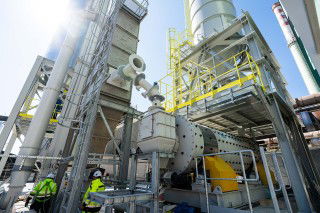This week Air Liquide partnered Lhoist for the operation of a carbon capture facility at Lhoist's Rety lime plant in France. ICR looks at how the lime sector has set about decarbonising and where its major pilot projects are starting up.
The Lhoist project in the Hauts-de-France region will capture 0.6Mta of CO2 and the captured gases are to be transported to a multimodal CO2 export hub, before being permanently stored in the North Sea as part of the D'Artagnan project. One of a number of similar project to decarbonise lime manufacture, the project will contribute to decarbonisation in the broader Dunkirk industrial basin.
EuLA's view
Europe is at the forefront of reducing CO2 emissions. The European Lime Association (EuLA) states that the lime industry decarbonisation measures are mainly 'end-of-pipe' solutions, such as carbon capture and storage or usage and carbonation, as 68 per cent of the industry's CO2 emissions are derived from processing raw materials. It is estimated that approximately 400Mta of CO2 are released into the atmosphere by the lime industry.
Under the 2009 EU ETS Directive, the CO2 recaptured during the production of precipitated calcium carbonate (PCC) is considered ‘emitted’ although it is permanently bound to the material. EuLA is calling for the inclusion of carbon capture and re-use under the ‘innovation fund’ proposed within the revision of the EU ETS. It also wants recognition of carbonisation during the lifecycle of the product as lime products act as a natural sponge for CO2 reabsorption.
German Lime Association
The German Lime Association is researching both carbon direct avoidance and smart carbon separation (SCS). Direct avoidance will require alternative fuels, and new kiln technologies using pure hydrogen or oxyfuel. Hydrogen can also be used with natural gas to reduce CO2 emissions in natural gas-fired kilns. This will mitigate about one-third of the lime sector's CO2 emissions.
SCS needs energy-efficient CO2 separation by a looping process, using a lime-based solid bed reactor. CO2 separation will be above 95 per cent and pure CO2 will have a high potential for utilisation beyond the lime industry. Pilot-scale projects have been in operation since 2020 and the phase II semi-industrial scale implementation was scheduled for 2021. Permanent storage of CO2 is planned in the Lausitz lake region of northeastern Germany.
Singleton Birch, UK
The Singleton Birch lime plant in the UK is working with Origen to develop an environmentally friendly way to produce lime with oxyfuel flash calciner technology. The resulting zero-carbon lime can be sold or used to strip CO2 from the flue gases of polluting industries, or to remove it directly from the air. A prototype plant capable of removing 2500-3000tpa of CO2 from the air was developed in 2021 and plans are advancing for a plant 20 times this size.
Carmeuse, Belgium
Carmeuse, another leading lime producer, has signed a joint development agreement with ENGIE and John Cockerill for a carbon capture utilisation (CCU) project in Wallonia, Belgium. The project will concentrate CO2 streams from a lime kiln to combine them with green hydrogen for e-methane production. The green hydrogen will be produced by a 75MW electrolyser plant powered by green electricity. Approximately, 0.9Mta of CO2 emissions will be avoided in the first 10 years for the project cost of EUR150m. The project implementation gets underway this year and it will be operational in 2025.
Nordkalk, Finland
Steel producers aim to work with the lime industry on decarbonisation as every tonne of steel requires more than 50kg of quicklime. Within the Fossil Free Steel (FSS) programme, funded by Business Finland (SSAB, Ovako Fortum, Valmet, Tapojärvi, Luxmet and Nordkalk), work package 6 will introduce fossil-free energy at Nordkalk's lime plants with results by mid-2023. Nordkalk's 'eLIMEnate' roadmap will lead to fossil-free operations by 2045.
Graymont, USA/Canada
In some parts of North America, attitudes are moving more slowly towards carbon capture. Graymont, a leading lime producer, stated in its 2020 Sustainability Report that "Breakthrough kiln technologies, eg carbon capture and storage, are on the horizon. However, it will be quite some time before we can avail ourselves economically viable, commercial-scale solutions that will enable us to markedly reduce combustion and process emissions."
Summary
Just like the cement sector, the lime industry is decarbonising. Lime production is hard to abate as most of its CO2 emissions arise from the processing of raw materials. Pilot projects are underway to capture carbon, while the support of the steel sector and options for the use of green hydrogen and oxyfuel flash calciner technology suggest that significant carbon reduction can take place in the industry in the coming years.
